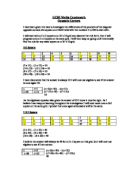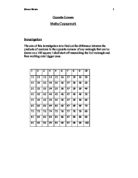1*22=22
2*21=42
42-22=20
We can now start to see a pattern developing to make sure that there is a definite pattern we will have to do another example
Example
1*32=32
2*31=62
62-32=30
As you can see from the results there is a definite pattern developed between the first two rows of number it seems to be going up by ten for each row you go down. We are going to do another example to see whether or not this is true throughout the square.
Example
3*14=42
4*13=52
52-42=10
For now it seems as though the pattern is working the same for the rest of the table. We need to justify our conclusion by drawing another two examples.
3*24=76
4*23=96
96-76 = 20
Again the same results seem to be occurring in this row but to be sure we will do one more example.
Example
3*34= 102
4*33= 132
132 – 102 = 30
As is confirmed by my results any rectangle that is 2 along and 2 down will be 10, then 2 along 3 down will be 20 and so on and so forth.
Now that we have a small result we can expand and see if a rectangle 3 along 2 down will also be 10 or if the results will change. I expect the results to change because we have changed the input numbers.
Example
1*13=13
3*11=33
33-13=20
As I hypothesised the results have changed as the size has changed if the pattern of the last results stays the same I am expecting a 3 by 3 square to be 40.
Example
1*23= 23
3*21= 63
63-23=40
As I predicted using my previous results the sum of the two corners has became 40 so there is an increase of 20 each time, again to confirm this I will do another example.
Example
1*33=33
3*31=93
93-33=60
This confirms my prediction.
Now that I have gathered some information I can create I table of my results
and of further predictions.
I could carry on but I am sure that you can see from the table that a 5*2 would be 40 then a 5*3 would be 80 and so on.
Justification
The formula for the sum of the opposite corners minus the sum of the two opposite corners is :-
(10x – 10) * (y – 1)
X = the number of squares across
Y = the number of squares down
An example of this is a 3 * 3 square would equal
(10*3 – 10) * (3-1)
= 20 * 2
= 40
If we work this out by multiplying the opposite corners and subtracted the sums we get
3 * 21 – 1 *23
= 63 – 23
= 40
This proves my formula works.









